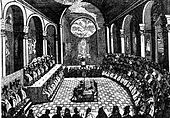
Back مجمع لاتران الخامس Arabic مجمع لاتران الخامس ARZ Conceyu de Laterano V AST Concili del Laterà V Catalan Pátý lateránský koncil Czech 18. økumeniske koncil Danish Fünftes Laterankonzil German Kvina Laterana koncilio Esperanto Concilio de Letrán V Spanish Laterango V. Kontzilioa Basque
This article needs additional citations for verification. (March 2009) |
| Fifth Council of the Lateran | |
|---|---|
| Date | 1512–1517 |
| Accepted by | Catholic Church |
Previous council | Council of Basel-Ferrara-Florence |
Next council | Council of Trent |
| Convoked by | Pope Julius II |
| President | Pope Julius II, Pope Leo X |
| Attendance | about 100 bishops, mostly Italians |
| Topics | Church discipline |
Documents and statements | five decrees, pawn shops allowed, permission required to print books |
| Chronological list of ecumenical councils | |
| Part of a series on the |
| Ecumenical councils of the Catholic Church |
|---|
 |
| 4th–5th centuries |
| 6th–9th centuries |
| 12th–14th centuries |
| 15th–16th centuries |
| 19th–20th centuries |
|
|
The Fifth Council of the Lateran, held between 1512 and 1517, was the eighteenth ecumenical council of the Catholic Church and was the last council before the Protestant Reformation and the Council of Trent. This was the first time since 1213 that the Papal States would hoist an ecumenical council. It would be the last time that Rome’s Lateran Palace (which had hoisted 4 ecumenical councils in the past) would be the venue for such a event.
It was convoked by Pope Julius II with a political motive of restoring peace between warring Catholic rulers and to re-assert the authority of the Pope.
After Pope Leo X took over in 1513, the Council attempted various institutional, dogmatic and social welfare reforms. Institutional reforms were intended to improve unity, reduce nepotism, absenteeism, disinterest, luxury and simony for high church officials, improve the training and regulation of priests, to strengthen the position of bishops over friars, and to assert the independence of the church and clergy from lay control. The social welfare reform allowed no-interest microfinance lending by monti di pietà.
These addressed some issues that had been raised by contemporary reformers, but were not the particular issues that the subsequent Protestant Reformation alighted on. As with the immediately previous Councils, its institutional reforms were ineffectively implemented at that time.